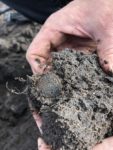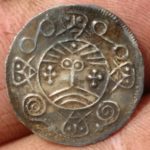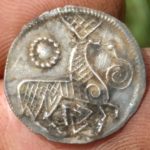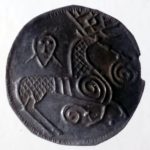 Archaeologists have discovered an exceptional group of more than 250 9th century coins in a bog near Ribe, Denmark. A metal detector hobbyist found the first coin earlier this year, an extremely rare piece known as a face/deer coin after the stylized face design on the obverse and the deer going nose-to-nose with a snake on the reverse. Only 11 face/deer coins were known to exist before this summer. The Museum of Southwest Jutland got wind of it on August 14th and contacted the finder the next day. That’s when they discovered there wasn’t just one more face/deer coin, but a whole bunch more, likely deposited in the wetland as a ritual sacrifice.
Archaeologists have discovered an exceptional group of more than 250 9th century coins in a bog near Ribe, Denmark. A metal detector hobbyist found the first coin earlier this year, an extremely rare piece known as a face/deer coin after the stylized face design on the obverse and the deer going nose-to-nose with a snake on the reverse. Only 11 face/deer coins were known to exist before this summer. The Museum of Southwest Jutland got wind of it on August 14th and contacted the finder the next day. That’s when they discovered there wasn’t just one more face/deer coin, but a whole bunch more, likely deposited in the wetland as a ritual sacrifice.
 With the help of the finder, museum archaeologists surveyed the site using metal detectors and precision GPS to document every discovery. Over two days, they found 174 coins, 172 of them face/deer coins, the last two with Viking ships adorned with shields on the obverse and deer on the reverse. The coins were spread over an elongated oval about 165 by 50 feet in area, a distribution typical of coin deposits that have been scattered by repeated passes with plows. The way they were spread out suggests they were not buried in the bog, but rather placed on the ground in a single deposit, likely in a bag that was torn apart and destroyed over the centuries.
With the help of the finder, museum archaeologists surveyed the site using metal detectors and precision GPS to document every discovery. Over two days, they found 174 coins, 172 of them face/deer coins, the last two with Viking ships adorned with shields on the obverse and deer on the reverse. The coins were spread over an elongated oval about 165 by 50 feet in area, a distribution typical of coin deposits that have been scattered by repeated passes with plows. The way they were spread out suggests they were not buried in the bog, but rather placed on the ground in a single deposit, likely in a bag that was torn apart and destroyed over the centuries.
 The team returned to the site in late October to excavate it. This time they found another 78 coins, 77 face/deer, 1 ship/deer. The condition of all of the coins is excellent. They were in such great shape that many of them shone like new through the clods of peat when they were recovered by the archaeologists.
The team returned to the site in late October to excavate it. This time they found another 78 coins, 77 face/deer, 1 ship/deer. The condition of all of the coins is excellent. They were in such great shape that many of them shone like new through the clods of peat when they were recovered by the archaeologists.
“This is an exceptional find that means a quantum leap in our understanding of minting. They are Danish coins and clearly minted for the purpose of being implemented in Ribe,” [Museum of Southwest Jutland’s Claus] Feveile told DR Nyheder.
“This completely shifts our understanding of how we used to mint and the process of coin production.”
 With no loops, perforations or clippings, it’s clear the coins were part of a money economy before their ritual deposition. The question of how much of a real monetary economy early Viking cities employed as opposed to a precious metal weight economy is a fraught one in the scholarship, and finding so many coins deposited in one place and preserved in perfect condition will give numismatic experts the unique opportunity to determine how many of these coins were minted and circulated. Initial examinations have already revealed that many different stamps were used to strike the coins, indicating a significant output that was in no way imaginable based solely on the two handfuls of coins known before this summer.
With no loops, perforations or clippings, it’s clear the coins were part of a money economy before their ritual deposition. The question of how much of a real monetary economy early Viking cities employed as opposed to a precious metal weight economy is a fraught one in the scholarship, and finding so many coins deposited in one place and preserved in perfect condition will give numismatic experts the unique opportunity to determine how many of these coins were minted and circulated. Initial examinations have already revealed that many different stamps were used to strike the coins, indicating a significant output that was in no way imaginable based solely on the two handfuls of coins known before this summer.
 When these coins were struck in the first half of the 9th century, Gudfred and later his sons ruled as kings of the Danes. Gudfred is the first Danish king we have decently reliable evidence of in contemporary chronicles. He fought against Charlemagne and the Franks. His son Horik I (the only son whose name is recorded but not the only one to rule) carried on his father’s legacy by raiding the Carolingian Empire of Charlemagne’s son Louis the Pious. We know little about Gudfred and his sons’ monetary policies or really much of anything about their reigns beyond their interactions with the Franks. The hoard may shed a whole new light on an obscure historical period.
When these coins were struck in the first half of the 9th century, Gudfred and later his sons ruled as kings of the Danes. Gudfred is the first Danish king we have decently reliable evidence of in contemporary chronicles. He fought against Charlemagne and the Franks. His son Horik I (the only son whose name is recorded but not the only one to rule) carried on his father’s legacy by raiding the Carolingian Empire of Charlemagne’s son Louis the Pious. We know little about Gudfred and his sons’ monetary policies or really much of anything about their reigns beyond their interactions with the Franks. The hoard may shed a whole new light on an obscure historical period.
The coins unearthed thus far were briefly on display at the Museum of Southwest Jutland for a week until November 4th before being removed for further study. The excavation at the find site continued through October 25th. Between August and now, a total of 252 coins have been recovered. Archaeologists don’t think there are many, or even any, left to find.